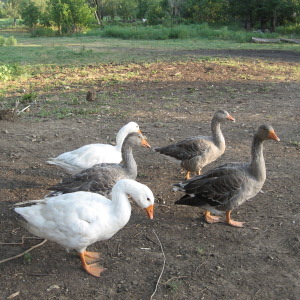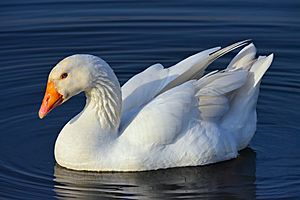Pilgrim goose facts for kids

A small flock of Pilgrim geese
|
|
| Conservation status | Critically Endangered (ALBC) |
|---|---|
| Other names | Settler Goose |
| Country of origin | America |
| Distribution | UK, America, Australia |
| Use | Commercial (eggs and meat) |
| Traits | |
| Weight |
|
| Skin colour | Male: White Female: Olive-grey |
| Egg colour | White |
| Classification | |
| APA | Medium goose |
|
|
The Pilgrim goose is a special type of goose. In Australia, it's called the Australian Settler goose. These geese are known for being calm, not too heavy, and medium-sized.
Pilgrim geese are quite rare. The American Livestock Breeds Conservancy (ALBC) says they are critically endangered. They were officially recognized in 1939. These geese can live a long time, usually between 15 and 25 years.
What makes Pilgrim geese unique is that you can easily tell the males and females apart. This is called auto-sexing. Male Pilgrim geese have white feathers. Females have grey feathers. This makes them popular for breeding because it's easy to know which is which! People mostly raise them in the United States for their eggs and meat. They grow quickly and are easy to care for.
Contents
Where Did Pilgrim Geese Come From?
The exact start of the Pilgrim goose is a bit of a mystery. Some people think these geese came from Europe. They might have been brought to America by pilgrims, which is how they got their name.
However, a goose expert named Oscar Grow said he created the breed in America in the 1930s. This was during the Great Depression. He said his wife named them "Pilgrim" because their family moved from Iowa to Missouri. Another expert, Dave Holderread, believes that small groups of auto-sexing geese probably existed in different parts of the world.
The Pilgrim goose was first officially written about in 1935. It was recognized in America in 1939. Then, it was recognized in the UK in 1982. In Australia, they were named "Settler geese" in 1984.
What Do Pilgrim Geese Look Like?
Pilgrim geese are medium-sized and medium-weight birds. Male geese, called ganders, usually weigh between 6.3 and 8.2 kilograms (14-18 pounds). Female geese weigh between 5.4 and 7.3 kilograms (12-16 pounds).
They have plump bodies with a smooth chest. Their heads are medium-sized and oval, with a flat top. Their necks are average length and slightly curved. They have a medium-sized beak that is straight. Both male and female adult Pilgrim geese have orange webbed feet and orange beaks. Their tails are medium length and folded close to their bodies. Their wings are strong and lie flat against their bodies.
Their feathers are hard and tight. They have fairly large eyes. The color of their eyes and feathers is different between males and females. This is how you can tell them apart.
How Do Pilgrim Geese Behave?
Pilgrim geese are known for being calm and friendly. They are usually quiet and gentle, not aggressive like some other goose breeds. They are also curious and very aware of what's happening around them. This is because they have excellent eyesight.
Because of their good awareness, they make great "watch birds." They will often honk to let their owners know if someone or something new is around.
These geese are also helpful for controlling weeds. They love to eat weeds, which keeps pastures tidy. Their droppings also act as natural fertilizer for the grass. This is good for the environment and doesn't use chemicals.
Pilgrim geese are good parents and take great care of their young. However, during breeding season, they become more protective. They might hiss or honk at people who get too close to their nest.
Compared to other domesticated geese, Pilgrim geese are also pretty good at flying.
What Do Pilgrim Geese Eat?
Pilgrim geese are good at finding their own food. They eat a lot of plant material. You can often see them grazing in fields, orchards, and yards. They also enjoy eating dandelions and other weeds.
Besides plants, they will also eat insects like larvae and pupae found under rocks. They also eat small water animals, seeds, tiny fish, snails, and crabs.
Reproduction and Life Cycle
Pilgrim geese grow quickly. They can gain 10 pounds in about 10 weeks. A male goose usually mates with 3 to 5 females. Males typically start mating when the females begin laying eggs.
Pilgrim geese can start laying eggs and raising their own babies when they are just one year old. Healthy female geese usually lay between 35 and 45 eggs each year. Their breeding season starts in late January or February and lasts until around June. During this time, they become more protective.
They lay the most eggs from early April to late May. While they usually lay eggs in spring, special lights can make them start laying eggs earlier. Their eggs are white and large, weighing about 6 to 7 ounces. About half of the eggs laid will hatch. Females usually sit on 8 to 10 eggs at a time. The eggs hatch after about 30 days.
For breeding, it's best to choose Pilgrim geese with broad backs and chests. This shows they are purebred. Geese with a knob on their beak, long necks, long legs, or shallow chests should not be used for breeding. These features suggest they might be a crossbreed.
Scientists have studied how to improve goose breeding. They found that with careful selection, geese can lay more eggs. They also found that fertility and hatching rates can improve over time. Younger females lay eggs that are a bit harder to hatch than eggs from older females.


